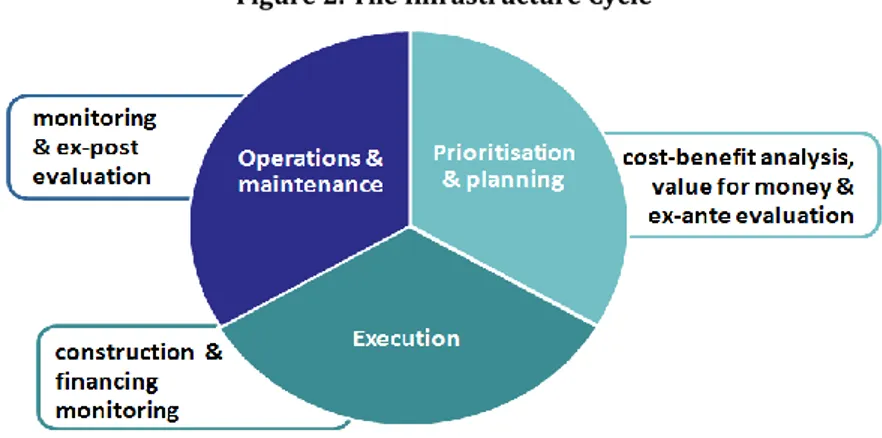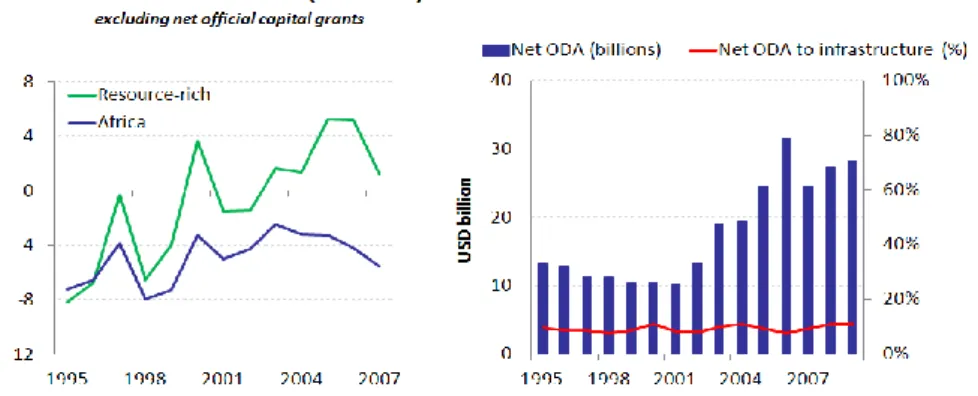Mobilising investment in
infrastructure and agriculture
Public investment in infrastructure:
an approach for sustainable development
This document has been prepared as a background document for the 5th NEPAD-OECD Ministerial Conference on 26-27 April 2011 in Dakar, Senegal.
2
development
An approach for
effective investment
in infrastructure
What can public
investment in
infrastructure
contribute?
What are the trends
in infrastructure
investment?
Are there resources
for public investment
in infrastructure?
Conclusion
Acknowledgments,
further information &
related reading
Infrastructure planning is essential for sustainable development
Africa’s urban population has exploded (Figure 1). Indeed, Africa has as many cities with more than 1 million people as Europe. Appropriate planning and prioritisation of investments in infrastructure will ensure the long-term sustainability of cities in Africa.
Figure 1. Urban population in Africa
An approach for effective
investment in infrastructure
Figure 2. The Infrastructure Cycle
© OECD 2011 4
What can public investment
in infrastructure contribute?
© OECD 2011 6
Figure 3. African exports (2009)
Figure 4. Prevalence of undernourishment (2007-2009)
Source: OECD Development Centre based on FAO.
What are the trends in
investment in infrastructure?
© OECD 2011 8
Figure 5. Growth rates in infrastructure investment
Source: OECD Development Centre based on WDI.
Are there resources for
public investment in
infrastructure?
Figure 6. Natural resources and ODA
Source: OECD Development Centre based on OECD, CRS and WDI.
© OECD 2011 10
Figure 7. FDI and lines of credit
Source: OECD Development Centre based on IMF, UNCTAD and OECD.
Conclusion
Acknowledgements
This position paper was drafted by Laura Recuero Virto with substantial input fromPapa Amadou Sarr and Eugenio Santagata. Andrew Mold, Sebastián Nieto Parra, Mario Pezzini, Carlos Alvarez, Henri-Bernard Solignac-Lecomte, Amalia Johnsson, Martha Baxter, Jan Rielaender, Bakary Traoré and Myriam Dahman Saidi also contributed.
Further information
For more information about this position paper and the OECD Development Centre’swork on infrastructure in Africa, please contact:
Andrew Mold, Competitiveness and Structural Analysis Unit, OECD Development Centre, Tel:+(33-1) 45 24 90 48, Email: Andrew.Mold@oecd.org.
Laura Recuero Virto, Competitiveness and Structural Analysis Unit, OECD
Development Centre, Tel:+(33-1) 45 24 85 49, Email: laura.recuerovirto@oecd.org.
Papa Amadou Sarr, Partnerships & Networks Unit, OECD Development Centre, Tel: +(33-1) 45 24 83 64, Email: papa-amadou.sarr@oecd.org.
Related reading
On infrastructure in Africa see: OECD (2012), Perspectives of Global Development 2012, OECD Publishing. Forthcoming
special issue on the Infrastructure Cycle and its Political Institutions in Transport. Bacache, M., Benelli, N. and L. Recuero Virto (2011), Telecommunications in Africa:
What is the right balance between government and private involvement?, forthcoming OECD Development Centre Working Paper, based on November 2010 OECD-AfDB expert meeting in Tunis.
OECD/African Development Bank (2009), African Economic Outlook 2009, AfDB/OECD Publishing. Special issue on Innovation and ICTs.
OECD/African Development Bank (2007), African Economic Outlook 2007, AfDB/OECD Publishing. Special issue on Access to Drinking Water and Sanitation. OECD/African Development Bank (2006), African Economic Outlook 2006,
AfDB/OECD Publishing. Special issue on Transport.
OECD/African Development Bank (2003), African Economic Outlook 2003, AfDB/OECD Publishing. Special issue on Energy.
On infrastructure in Latin America see:
OECD (2012), Perspectives on Global Development 2012, OECD Publishing.
Forthcoming special issue on the Infrastructure Cycle and its Political Institutions in Transport.
OECD (2011), Latin American Economic Outlook 2012, OECD Publishing. Forthcoming
chapter on the Infrastructure Cycle and its Political Institutions in Transport.
OECD (2007), Latin American Economic Outlook 2008, OECD Publishing. Chapter on Business for Development: Multinationals, Telecommunications and Development. On infrastructure in Asia see:
OECD (2012), Perspectives on Global Development 2012, OECD Publishing.
Forthcoming special issue on the Infrastructure Cycle and its Political Institutions in Transport.
OECD (2012), Southeast Asian Economic Outlook 2012, OECD Publishing. Forthcoming
special issue on the Infrastructure Cycle and its Political Institutions in Transport. OECD (2010), Southeast Asian Economic Outlook 2010, OECD Publishing. Special issue
© OECD 2011 12
OECD Development Centre
Policy solutions to improve lives in developing and emerging economies
Following a proposition by US President John F. Kennedy, the Development Centre was created in 1962 by the Organisation for Economic Co-operation and Development (OECD) in Paris. For nearly 50 years the Centre has served as an interface between OECD member countries and emerging and developing economies, providing an independent platform for policy dialogue and mutual learning on economic and social development policies.
The Centre occupies a unique place within the OECD with its Governing Board composed of 25 OECD and 16 non-OECD members among which are five African countries: Cape Verde, Egypt, Mauritius, Morocco, Senegal and South Africa. All these members finance the Centre and set and monitor its programme, on an equal footing.
The Centre’s flagships include: (i) African Economic Outlook; (ii) Latin American Economic Outlook; (iii) Southeast Asian Economic Outlook; and (iv) Perspectives on Global Development.
The Centre manages networks: (i) EmNet, the Emerging Markets Network dedicated to the private sector; (ii) DeFiNe, a global network of think tanks and academic establishments; and (iii) DevCom Network which gathers directors of communication/public affairs from the DAC Member countries.


